Temporalis Muscle
Introduction
In anatomy, the temporalis muscles, also known as the temporal muscle, are one of the muscles of mastication (chewing). It is a broad, fan-shaped convergent muscle on the individual side of the head that fills the temporal fossa, superior to the zygomatic arch so it obscures much of the temporal bone. Temporal guides to the head’s temples.
The temporalis muscles are thin, fan-shaped muscles situated within the temporal fossa of the skull. Also Along with the medial pterygoid, lateral pterygoid, and masseter muscles, it belongs to the group masticatory muscles. The temporalis muscles run superficially, from the temporal bone to the coronoid process of the mandible.
The main function of this muscle is to create the movements of the mandible at the temporomandibular joint and therefore facilitate the act of mastication. Its anterior portion moves the mandible dorsocranially (elevation) motion while its posterior fibers pull the mandible posteriorly (retrusion). The temporalis muscles are emanated from the first pharyngeal arch in development
Origin of Temporalis Muscle
The temporalis muscle is a wide muscle that occupies most of the temporal fossa. Its origin point traverses the whole surface of the fossa below the temporal line. Additionally, some fibers arise from the temporal fascia as well.
Insertion
The temporalis muscles are divided into the anterior and posterior portions. The anterior fibers run inferiorly, in a nearly vertical direction, while its posterior fibers are directed almost horizontally. Both anterior and posterior fibers merge onto a narrow tendon that runs medial to the zygomatic arch. The tendon inserts onto the apex and medial character of the coronoid process of the mandible.
The temporalis muscle protects the temporal fossa with its deep surface. Superficially, the muscle is protected by the temporal fascia, masseter muscle, subcutaneous tissue, and skin. The auriculotemporal, facial, and zygomaticotemporal nerves run across the superficial element of the temporalis muscle.
Nerve supply
The temporalis muscle receives its innervation from the anterior, middle, and posterior deep temporal branches of the anterior division of the mandibular nerve (V3).
Blood supply
The temporalis muscle acquires its blood supply from the deep temporal branches of the maxillary artery and the middle temporal branches of the superficial temporal artery.
Function of Temporalis Muscle
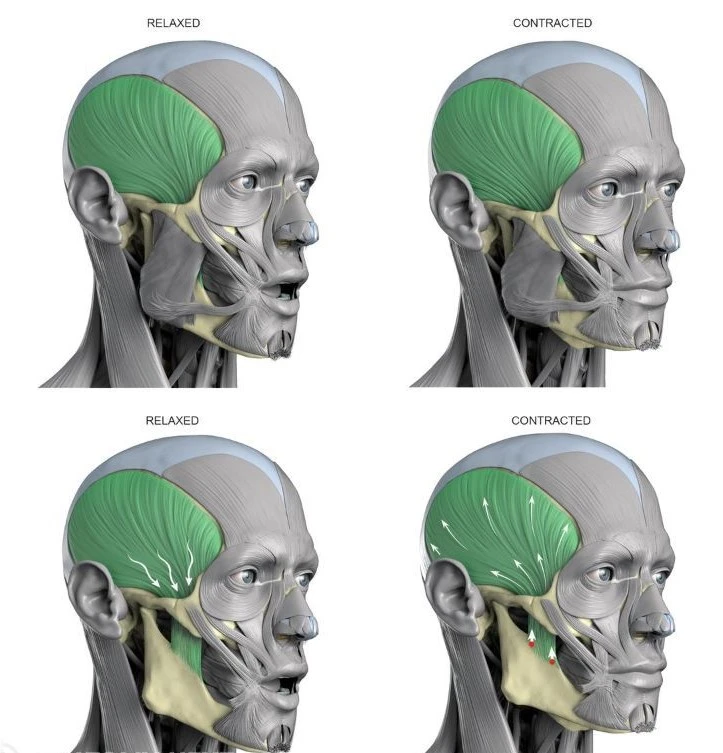
The temporalis muscle is the most powerful muscle of the temporomandibular joint and the primary retractor of the mandible. The contraction of the posterior fibers of the temporalis muscles results in the backward movement of the mandible (retrusion). The contraction of its anterior fibers drags the mandible dorsocranially (elevation). In unison, these motions facilitate the closing of the mouth and the approximation of the teeth. Additionally, the unilateral contraction of the temporalis muscle recreates an important role in the side-to-side movements of the jaw. Motor divisions are recruited the most when they have maximal leverage, maximizing contractile strength. When lower dentures are fitted, they should not grow into the retromolar fossa to control the trauma of the mucosa due to the contraction of the temporalis muscle.
Clinical significance
Hypertrophied temporal muscles
The temporalis muscle is likely to be affected by jaw pain and headaches. Bruxism, the habitual grinding of teeth typically while sleeping, and clenching of the jaw while stressed can guide to overwork of the temporalis muscle and result in pain.
Seizure
A myotendinous rupture of the temporalis muscles can occur during a seizure due to excessive clenching of the jaw. During a seizure, the contralateral temporalis muscles can enter spastic paralysis, this clenching in severe cases can lead to a rupture specifically on the myotendinous insertion at the coronoid process of the mandible.
Surgery
The temporalis muscles may be used in reconstructive surgery of the mouth. During pterional craniotomy, incisions are usually chosen based on the ease of reattaching the temporalis muscle after the bone fragment is replaced.[
The tension of the temporal muscle can generate pain in the temporal area. Common causes include misalignments of the teeth and jaws, trauma, prolonged immobilization (e.g. after a mandibular fracture), teeth grinding (bruxism)a dental intervention during which the person’s mouth is held to be open for a long period. Clinically, it is important to lead out inflammation of the superficial temporal artery, which runs in front of the ear along the zygomatic arch to the temporal area. Vasculitides, such as giant cell arteritis, oftentimes involve the superficial temporal artery and cause swelling and massive pain in the temporal area. The diagnosis can be established by a temporal artery biopsy.
Exercise of Temporalis Muscle
Compress and Stretch
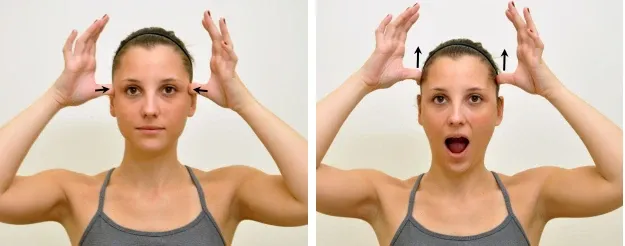
- Place the pad of the thumb of both hands just above the cheekbones and press in.
- While slowly extending the mouth, press in against the jaw muscles(temporalis) with the thumbs. Slowly slide the thumbs upward and along with the muscles.
- End the compression and stretching when you complete the edge of the muscles, which is about 1-2” above the ear.
- Repeat at least 10 times.
- Be sure to address tension in all places of the muscle (blue shaded are to the right).
- Applying some ointment to the face may make the stretch easier and more comfortable. Unless otherwise indicated below, perform this stretch 4-6 times daily.
Jaw TMJ retraction
Using your fingers, push the bottom of your jaw backward towards the throat.
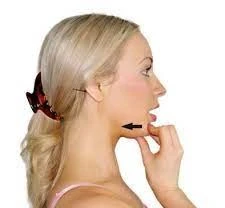
Massage
Sets: 5 minutes
Reps: 15-20 seconds
Caption: The temporalis is a strong muscle acting at the TMJ joint, exerting hundreds of kilograms of pressure, therefore this muscle must remain relaxed to avoid discomfort and permit the joint to perform its important motions such as chewing and opening/closing. A short temporalis can guide teeth clenching, which can harm sensitive proprioceptive covering on the teeth.
Use your thumb and fingers and use pressure along the muscle, beginning just above the temple area and down towards the jaw. By clenching the teeth gently, you should feel the muscle contracting. Apply pressure to the muscle holding for 15-20 seconds, during which the discomfort should begin to diminish. You can also slide your fingers along with the muscles as a release technique.
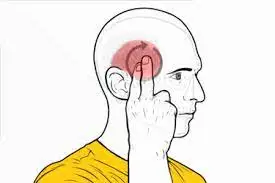
Strengthing
Jaw Push: Using mild pressure can help strengthen your temporalis muscle. Sit upright in a firm chair. Gently separate your teeth while maintaining your mouth closed. Slowly move your teeth back with your chin until you sense your jaw motion. Gently cup your chin and lower jaw with the entrapment between your thumb and forefinger. Gently push your whole jaw forward into your hand. Hold for eight seconds.
While relaxing your hand, slowly and gently push your lower jaw ahead until your lower teeth protrude. Do not move your hand or head. Hold this pressure for three seconds. Release the tension and slowly replace your jaw to its original position.
Relax for 15 seconds. Repeat the exercise eight times.

Tongue Workout: Your tongue can be used to strengthen your temporalis muscles. Sit upright in a firm chair, with your back against the seat. Gently close your jaw and teeth together. Place the tip of your tongue slightly behind the top of your front teeth. While maintaining your teeth closed, slowly move your tongue tip backward until your tongue surrounds the top of your mouth. Keep moving your tongue spike until you just feel your soft palate.
Keep your tongue in position and slowly open your mouth until your tongue begins to move away from your soft palate. Open your mouth as wide as possible without allowing your tongue to move. Hold this position for eight seconds.
Slowly shut your mouth and return your tongue to its original position. Relax for 10 seconds. Repeat this exercise twice. Stop this exercise at the foremost sign of pain, clicking, tongue motion, or popping.
Chewing Maneuvers: Chewing is one of the functions executed by your temporalis muscle. Enhance this function by maintaining your muscles strong and using chewing gum as an exercise tool. Place one element of your favorite gum into your mouth. Slowly start opening and comfortably closing your mouth while chewing the gum. Open and close your mouth in an up-and-down manner. Do not extend your mouth too far. Chew the gum for at least one to two minutes. Remove the gum and toss it out. Repeat this exercise twice daily.
If your jaw is strong adequately, move your jaw from side to side while chewing your gum. If the gum is not to your liking, select chewy foods such as caramels, taffy, whole grain bread, or fresh fruits and vegetables.
Fist Holdings: Use your fist as an exercise aid to assist strengthen your temporalis muscle. While seating upright position in a firm chair, gently close your mouth and teeth. Place your fist under your chin, according to the National Health Service. Slowly and firmly extend your jaw and press it into your fist. Hold this pressure for eight seconds. Do not move your fist. Release the tension and replace your jaw with its initial position. Relax for 10 seconds. Repeat this exercise 10 times.
FAQ
Why is it called temporalis?
The temporalis muscle is a muscle that gets its title based on its location in the body. This muscle is a fan-shaped muscle located at the temporal bone in the skull, which is a bone on the side of the skull.
What is the clinical importance of temporalis?
The temporalis muscle is a very important muscle concerning mastication, reducing temporomandibular dislocations, and as a landmark distally for identifying the long buccal nerve.
What is the function of the temporalis muscle?
The temporalis muscle is only of the muscles of mastication. It is responsible for both closing the mouth and also retraction (posterior fibers).
How do you check the temporalis muscle?
Trigger points in the temporalis are palpated with the mouth partially open to place the muscle fibers on the stretch. Trigger ends in the anterior and intermediate fibers are palpated just above the upper border of the zygomatic arch. Trigger points in the posterior fibers are palpated beyond the ear.
How do you activate temporalis?
A short temporalis can lead to teeth clenching, which can damage the sensitive proprioceptive surface of the teeth. Use your thumb and fingers and apply pressure along the muscle, beginning just outside the temple area and down towards the jaw. By clenching the teeth gently, you should feel the muscle contracting.

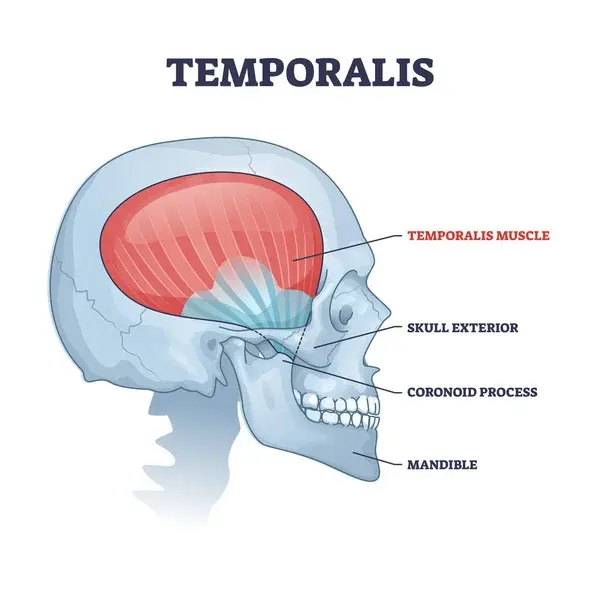

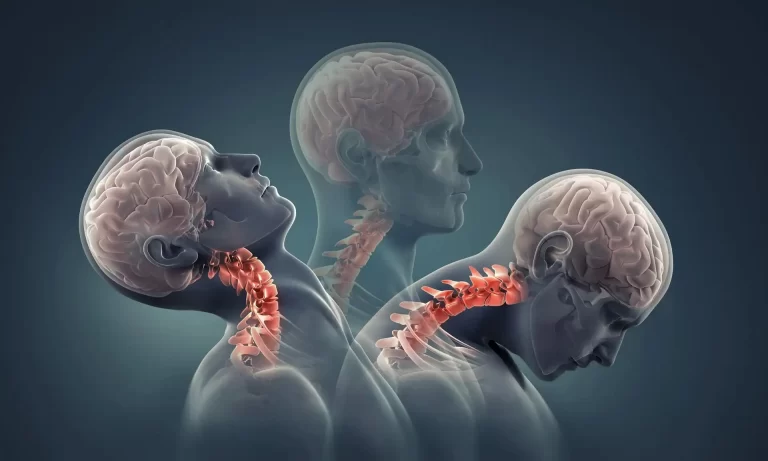
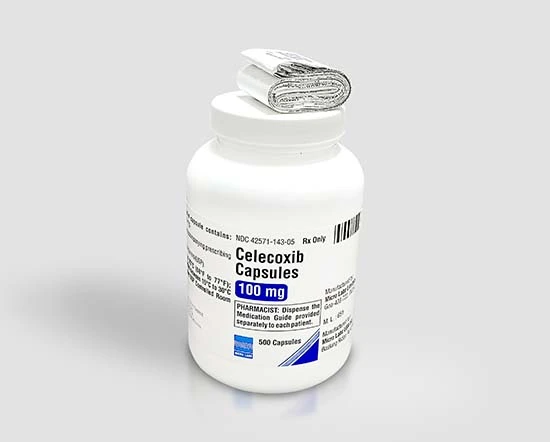
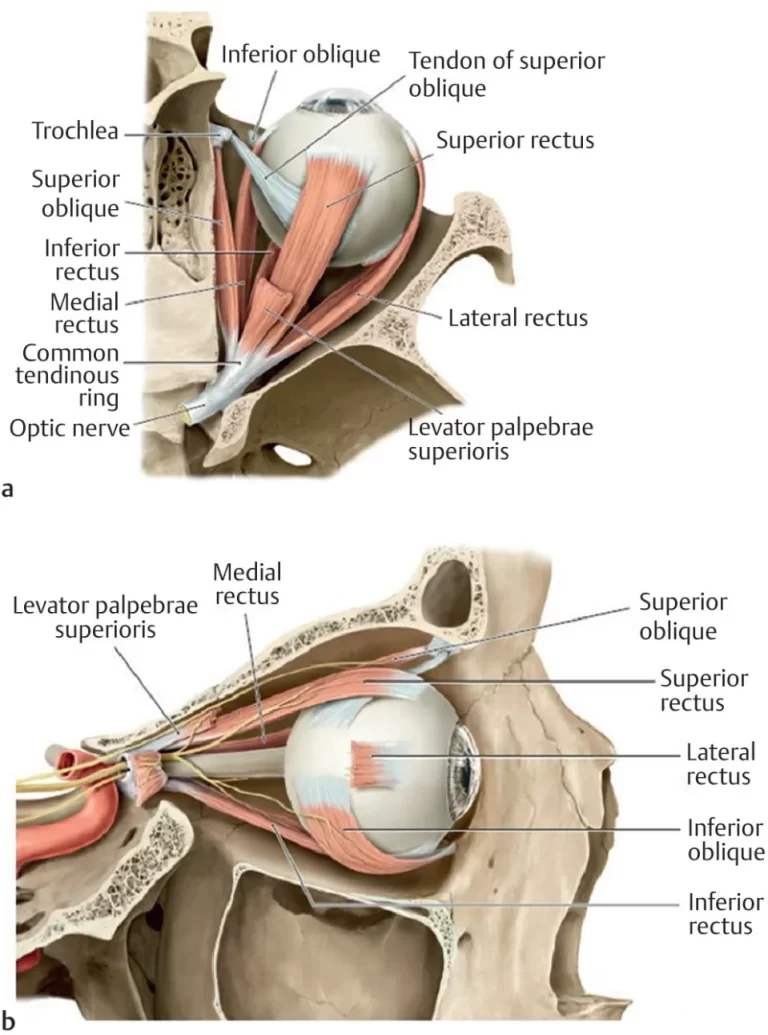
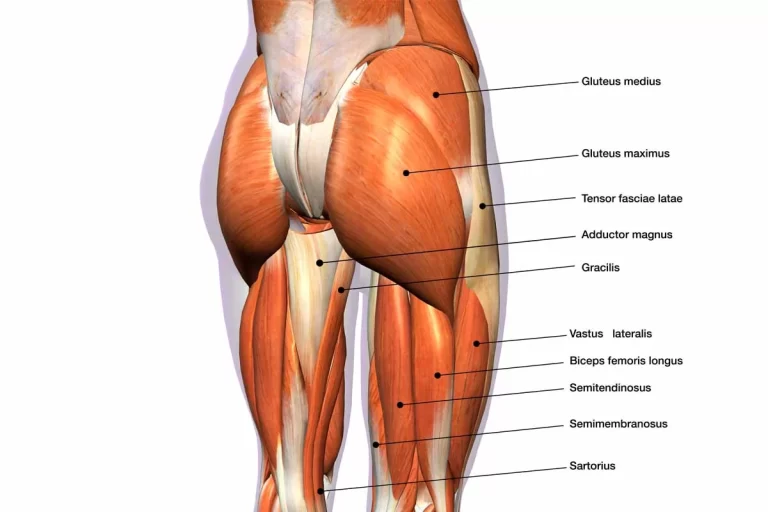
One Comment